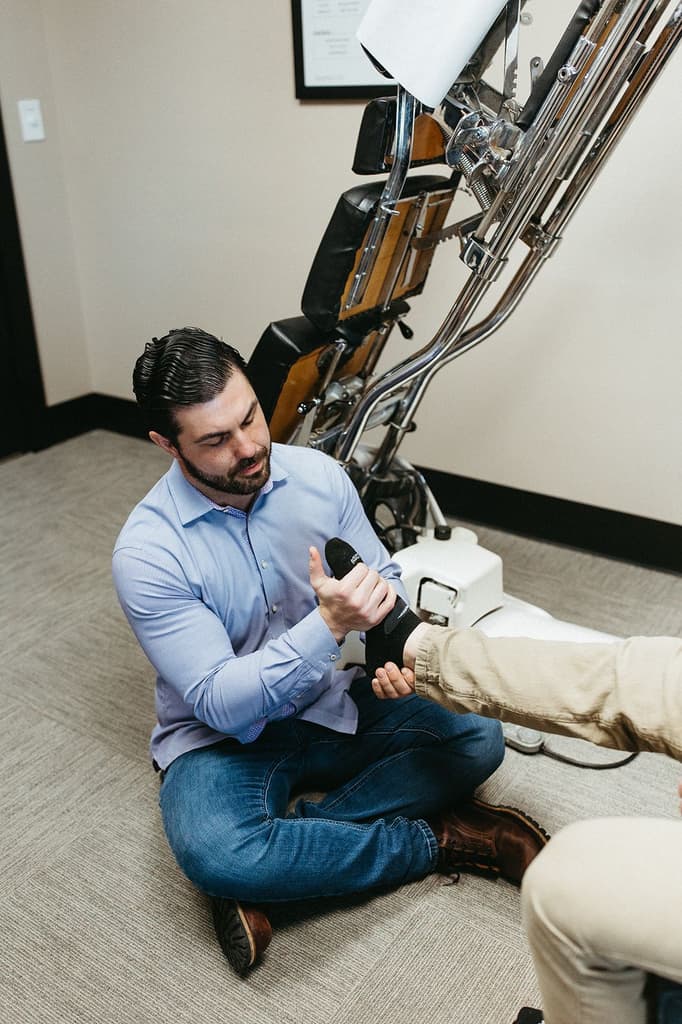Gonstead chiropractic is a precise chiropractic technique that focuses on spinal alignment to improve joint health and overall mobility. Developed by Dr. Clarence S. Gonstead, this method uses a detailed five-step diagnostic process – visual observation, palpation, X-ray analysis, and instrumentation – to identify and correct spinal misalignments. By targeting the root cause of joint issues, it enhances nerve function, reduces inflammation, and improves movement in areas like shoulders, hips, knees, and ankles.
Unlike broader chiropractic methods, Gonstead adjustments are highly specific, focusing on individual vertebrae to avoid unnecessary manipulation. This approach is suitable for all ages and emphasizes long-term joint health. Clinics like Kinnection Clinic combine Gonstead care with functional medicine and regenerative therapies to address both structural and biochemical factors affecting joint health.
Core Principles of Gonstead Technique for Joint Care
Precise and Specific Adjustments
What sets the Gonstead technique apart from other chiropractic methods is its highly targeted approach to spinal corrections. Instead of adjusting multiple areas indiscriminately, Gonstead practitioners focus solely on the specific vertebrae causing the issue.
The adjustments themselves involve short lever, high velocity, low amplitude movements, often combined with long lever assist force. In simpler terms, the chiropractor uses quick, controlled motions to correct the problem with maximum precision. This approach minimizes unnecessary manipulation while delivering effective results.
Dr. Clarence Gonstead, the pioneer of this method, believed that accuracy was the cornerstone of chiropractic care. He famously stated:
"The principles of the Gonstead Method are the simple principles of chiropractic put to work; how to understand what causes nerve pressure, how to find it on the patient, how to achieve a corrective setting of the offending vertebra, and how to know when the chiropractor’s job is done, and nature’s begins."
This focus on precision is more than just a hallmark of the technique – it’s essential. Dr. Gonstead emphasized that repeated adjustments on the wrong vertebra could lead to a subluxation. By honing in on the exact problem area, the Gonstead technique avoids creating new issues while resolving the existing ones. This dedication to accuracy lays the groundwork for its thorough diagnostic process, which is discussed in the next section.
Diagnostic Tools Used in Gonstead Care
The Gonstead system relies on an in-depth evaluation process that goes beyond the standard assessments used in many other chiropractic methods. By combining a variety of diagnostic tools, practitioners can get a complete picture of spinal health.
One of the core tools is full spine X-rays, which provide a detailed view of vertebrae and pelvic alignment. These images allow practitioners to identify misalignments that might not be evident through physical exams alone.
Another key tool is the Nervoscope (or Delta-T), a dual-probe device that measures para-spinal skin temperature to detect inflammation. This helps pinpoint areas where nerve interference might be disrupting normal body function.
In addition, static and motion palpation are used to evaluate tissue texture, tone, temperature, and movement restrictions. These hands-on techniques help practitioners identify problem areas more precisely.
Finally, visual observation of posture, gait, and range of motion completes the assessment. This multi-faceted approach ensures no potential issue is overlooked.
Dr. Gonstead’s relentless commitment to thorough diagnostics is evident in his fifty-five years of practice, during which he performed over four million adjustments. His detailed biomechanical analysis has become the foundation of what many consider one of the most effective methods for addressing joint health. This diagnostic rigor also extends to treating joint issues in the arms and legs.
Focus on Arm and Leg Joint Health
The Gonstead technique doesn’t stop at spinal adjustments – it also emphasizes the importance of arm and leg joint health. It recognizes that spinal misalignments can ripple through the body, affecting other joints and systems.
Gonstead practitioners are often seen as specialists because of their focus on intervertebral disc health. Dr. Gonstead believed that healthy discs are essential for maintaining proper nerve function, which in turn supports the joints in the arms and legs.
By concentrating on restoring alignment and motion, the technique helps intervertebral discs function optimally. Dr. Gonstead identified these discs as a root cause of many neurological issues. When discs are properly aligned, nerve signals can travel freely to muscles and joints, improving overall function.
As a result, patients often report better mobility and reduced discomfort in areas like the shoulders, elbows, wrists, hips, knees, and ankles after receiving precise spinal adjustments. By addressing the underlying disc issues rather than just the symptoms, the Gonstead method provides lasting improvements in joint health and overall mobility.
Step-by-Step Guide to Gonstead Joint Adjustments
Initial Assessment and Preparation
The first step in Gonstead joint care starts with a visual evaluation of your posture, gait, and movement patterns. This observation helps identify potential joint issues even before a more detailed examination begins.
The assessment relies on five key components: Visualization, Instrumentation, Palpation, X-Ray, and patient-reported symptoms. Together, these tools help pinpoint the exact areas that need attention.
To ensure an accurate evaluation, you’ll be asked to change into a gown. This allows the chiropractor to closely examine your skin, posture, and alignment. Observing your natural alignment can reveal signs of stress or compensation that might not be immediately obvious.
Full spine X-rays are then used to confirm vertebral alignment and detect any misalignments. These images provide a detailed view of your spine and help the chiropractor understand how spinal issues may be affecting other joints, such as those in your arms or legs.
Next, a physical evaluation is conducted. Using both static and motion palpation, the chiropractor identifies areas of tenderness, muscle spasms, and range-of-motion limitations. This hands-on approach locates specific spots where restrictions or dysfunctions are present.
The final step in the assessment involves a hand-held device, like a nervoscope, to measure temperature variations along your spine. These readings help identify inflammation or nerve interference. By combining all these findings, the chiropractor creates a complete clinical picture to guide your treatment.
With the assessment complete, the adjustment process can begin.
The Adjustment Process
After the evaluation, your chiropractor will position you for a precise adjustment based on the identified misalignments. The goal is to apply a controlled force to the problematic vertebra, restoring proper nerve function and improving both spinal health and the function of related joints in your arms and legs.
Your position during the adjustment – whether lying on your side, face down, or seated – is customized to target the specific area needing correction. If extremity joints like shoulders, elbows, wrists, hips, knees, or ankles require attention, these are also adjusted directly, while keeping the primary focus on spinal alignment.
Dr. Gonstead emphasized that "anatomically and physiologically normal discs promote optimum vertebral alignment". This principle highlights the importance of spinal health in maintaining overall joint function. During the adjustment, you might hear a popping or clicking sound as the joint alignment is restored.
Post-Adjustment Care and Follow-Up
Once the adjustment is complete, the chiropractor reassesses your condition to confirm the results. They will check your range of motion, evaluate areas of tenderness, and may use instrumentation again to ensure the adjustments were effective.
Aftercare instructions are provided to help your body recover. These might include avoiding heavy lifting, modifying your sleeping position, and staying hydrated for the next 24 to 48 hours. Following these guidelines is essential for supporting your recovery and maintaining the benefits of the adjustment.
Depending on your condition and how your body responds, follow-up appointments will be scheduled. Your chiropractor may also suggest simple exercises or stretches to help sustain the improvements achieved during treatment.
The Gonstead approach prioritizes the health of intervertebral discs, as these play a critical role in overall joint function. Regular check-ups are encouraged to maintain spinal alignment, ensuring optimal nerve function and long-term joint health in both your arms and legs.
Benefits and Considerations of Gonstead Joint Care
Main Benefits of Gonstead Adjustments
Gonstead adjustments focus on correcting misaligned vertebrae with precision, offering relief that lasts and improving how joints function overall.
By addressing spinal subluxations – misalignments that can compress nerves and cause inflammation – these adjustments aim to tackle pain at its source. This approach often leads to noticeable and lasting relief for patients.
Another key advantage is the improvement in range of motion and joint function, especially in extremities. This makes Gonstead care particularly helpful for individuals dealing with conditions like sciatica or disc herniation. Beyond pain relief, patients may also notice reduced inflammation, better posture, and stronger joint stability. These results highlight the precision and effectiveness of Gonstead adjustments compared to more general chiropractic techniques.
Gonstead vs. Other Chiropractic Techniques
The Gonstead method distinguishes itself from traditional chiropractic practices through its detailed and focused approach. A quick comparison shows how it differs:
| Aspect | Gonstead Technique | Traditional Chiropractic |
|---|---|---|
| Diagnostic Approach | Involves a five-step process: X-rays, palpation, instrumentation, visualization, and a thorough health history. | Diagnostic tools and methods vary by practitioner, often using fewer steps. |
| Adjustment Precision | Targets specific problem areas, focusing on individual vertebrae and joints. | Adjustments are often applied to broader regions of the spine. |
| Assessment Method | Includes detailed X-ray analysis and specialized tools for evaluation. | Assessments may be less detailed or comprehensive. |
| Treatment Philosophy | Aims to correct the root cause of issues, not just relieve symptoms. | Often prioritizes symptom management. |
| Practitioner Training | Requires advanced expertise in specialized techniques and tools. | Involves general training across various methods. |
The Gonstead technique has earned a strong reputation over decades, often regarded as the "gold standard" in chiropractic care. This reputation is rooted in the meticulous work of Dr. Clarence Gonstead, who refined the method over 55 years of practice.
Treatment Considerations
While the benefits of Gonstead adjustments are well-documented, there are important factors to consider to ensure this care aligns with individual patient needs. Its precision makes it an excellent choice for addressing chronic pain issues like backaches, neck pain, and headaches. Plus, the technique’s flexibility allows it to be tailored to patients of all ages and physical conditions.
A key part of Gonstead care is its comprehensive approach, which includes educating patients about their condition, treatment plan, and any lifestyle changes that might support recovery. This ensures patients are actively involved in their healing process.
Before starting treatment, it’s a good idea to consult with your primary healthcare provider and confirm that your chiropractor is licensed and certified. Sharing a complete medical history and discussing current symptoms will also help the practitioner create the most effective treatment plan.
It’s worth noting that achieving long-term structural improvements typically requires multiple sessions. In some cases, additional medical treatments or therapies may complement Gonstead care. Choosing a skilled and qualified practitioner is crucial for getting the best results.
sbb-itb-d9e542d
Combining Gonstead Chiropractic with Functional Medicine at Kinnection Clinic

Complete Approach to Joint Health
At Kinnection Clinic, the integration of Gonstead chiropractic care and functional medicine offers a well-rounded approach to joint health. By addressing both structural misalignments and biochemical imbalances, this method goes beyond simply correcting spinal issues – it tackles the systemic factors that can affect joint integrity.
Gonstead chiropractic focuses on realigning the spine to enhance nervous system function and improve posture. Functional medicine, on the other hand, dives deeper into how genetics, environment, lifestyle, and nutrition shape overall health. Together, this dual approach uncovers root causes of joint problems, such as inflammation, nutrient deficiencies, or hormonal imbalances, which may otherwise go unnoticed.
Functional medicine consultations at Kinnection Clinic take a detailed look at a patient’s health history, symptoms, and lifestyle. Often, advanced lab tests are used to pinpoint biomarkers affecting joint health. This thorough evaluation forms the basis of a multidisciplinary plan that incorporates nutrition, movement, mindset, and cutting-edge testing to provide a complete picture of a patient’s well-being.
The results speak for themselves. Take Samuel Johnson, for example. In January 2025, after 15 years of rib and collarbone pain and spending thousands on various chiropractors and massage therapists, one adjustment from Dr. Lars at Kinnection Clinic brought him complete relief. Dr. Lars also resolved Johnson’s chronic TMJ issues caused by teeth grinding – a problem he had endured for over a decade.
This comprehensive approach not only alleviates pain but also sets the stage for additional therapies to further enhance joint health.
Additional Services for Joint Health
Kinnection Clinic doesn’t stop with Gonstead chiropractic and functional medicine. The clinic also offers complementary services designed to amplify joint health and support the body’s natural healing mechanisms.
- Regenerative medicine: Treatments like PRP (platelet-rich plasma) therapy and peptide therapies focus on repairing and regrowing damaged joint tissue at the cellular level, offering a proactive alternative to symptom-focused care.
- IV therapy: Custom nutrient infusions deliver essential vitamins, minerals, and antioxidants directly into the bloodstream. This bypasses digestive absorption issues and provides targeted support for joint health.
- Hormone replacement therapy: Hormonal imbalances can lead to inflammation, reduced bone density, and slower tissue repair. The clinic uses bioidentical hormone therapy to restore balance and improve joint function.
These services work together to repair tissue, reduce inflammation, and promote overall hormonal balance, creating a stronger foundation for joint health.
Personalized Wellness Plans at Kinnection Clinic
Kinnection Clinic takes pride in crafting individualized wellness plans tailored to each patient’s needs. Instead of a one-size-fits-all approach, the clinic develops strategies based on the patient’s health history, unique challenges, and personal goals.
The process begins with comprehensive diagnostics, which may include digital X-rays, advanced lab testing, and detailed health assessments. This thorough evaluation helps identify the specific factors contributing to a patient’s joint issues and informs the creation of a targeted treatment plan.
The functional medicine model at Kinnection Clinic incorporates advanced lab testing, personalized nutrition and supplement plans, and lifestyle adjustments. Research from Cleveland Clinic supports this model, showing that it improves health-related quality of life.
Patient feedback highlights the success of these personalized plans. The clinic’s 5.0 rating reflects consistent satisfaction, with patients frequently sharing stories of relief after years of pain and frustration with other treatments. Many report not just improved joint health but also an overall boost in vitality.
Kinnection Clinic caters to patients of all ages, offering specialized care for babies, children, and pregnant women. This ensures that joint health support is available through every stage of life, from early development to aging and beyond.
Emotional Extremity Adjustment, AC joint, knee, ankle by Dr Suh Gonstead Chiropractic NYC
Conclusion
Gonstead chiropractic provides a focused and precise method for improving joint health, going beyond the scope of traditional spinal adjustments. Created by Dr. Clarence S. Gonstead and widely respected within the chiropractic profession, this technique offers key advantages like pain relief, better mobility, and reduced inflammation [19, 31].
What sets this method apart is its emphasis on personalized care and accuracy. By conducting detailed examinations and delivering targeted treatments, Gonstead chiropractic works to restore proper function to injured spinal joints and alleviate nerve irritation, promoting better neuromuscular health overall.
At Kinnection Clinic, this approach is taken a step further by combining it with functional medicine, regenerative therapies, and customized wellness plans. Using advanced diagnostic tools and the expertise of Dr. Lars Gunnar, the clinic addresses not only spinal misalignments but also the biochemical factors that influence joint health. This comprehensive strategy strengthens the link between precise spinal care and long-term joint well-being. If you’re looking to tackle the root causes of your discomfort, consulting a Gonstead chiropractor could be the first step toward lasting relief.
FAQs
What makes the Gonstead chiropractic technique unique compared to traditional chiropractic methods?
The Gonstead chiropractic technique is known for its highly detailed approach to both diagnosis and treatment. Unlike methods that take a broader or more generalized approach, Gonstead chiropractors use tools like full spine X-rays and temperature readings to accurately identify the precise location of spinal misalignments.
This method focuses on adjusting specific areas of the spine to correct alignment and support the proper functioning of the nervous system. By tackling the underlying cause of problems instead of merely addressing symptoms, Gonstead care helps promote lasting joint health and overall well-being.
How can combining Gonstead chiropractic care with functional medicine improve joint health?
Combining Gonstead chiropractic care with functional medicine offers a well-rounded strategy for improving joint health. Gonstead adjustments aim to correct misalignments in the spine and joints, which can boost nerve function and relieve discomfort. On the other hand, functional medicine addresses deeper issues like inflammation or nutritional deficiencies that might be contributing to joint problems.
By working together, these two methods not only help ease pain and enhance mobility but also support long-term joint health. This dual approach tackles both structural and internal challenges, delivering more effective and lasting outcomes for overall well-being.
How can Gonstead chiropractic adjustments help with joint problems in the arms and legs?
Gonstead chiropractic adjustments are a targeted approach to addressing joint problems in the arms and legs. By concentrating on precise alignment of the spine and extremities, these adjustments aim to reduce nerve interference, ease pain, and improve how your joints function.
This method relies on thorough assessments, such as palpation and X-rays, to pinpoint misalignments or subluxations. Once identified, specific adjustments are made to correct these issues, helping to restore mobility and promote healthier joints over time.



